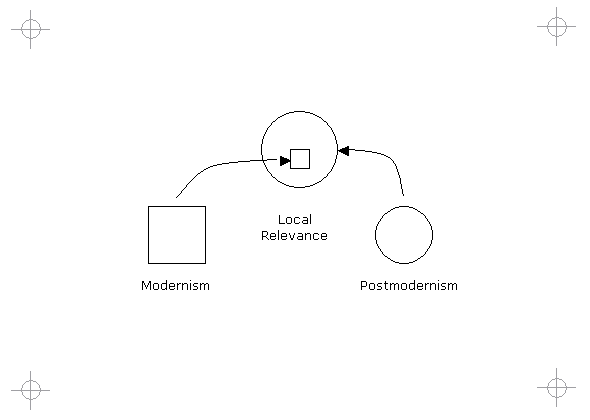|
Diagram
|
|
|

|
|
Title
|
|
|
Modernism in Postmodern World
|
|
Building Architecture
|
|
|
Much of the world would still find modernism relevant in order to reach a postmodern state.
|
|
Architecture Intensive Disciplines
|
|
|
In some parts of the world where there is a convergence of culture and technology, modernism has specific relevance. Structured methods and geometric models will be used to develop knowledge and skills, particularly in information technology. Countries such as China, India and South Africa are undergoing this convergence and it is driving social change. In South Africa modern, postmodern and natural architecture (thinking and values) are all relevant because of the cultural diversity.
|
|
Case Study A: Large Corporate IT
|
|
|

|
|
|
As with any organisation in South Africa, this model is relevant. The pattern is not always obvious but whenever one examines disparity in thinking, it always helps to take a step back and consider this pattern. Particularly in IT where we tend to follow a modernist approach. Some people find it hard to express themselves in "bullet pionts" and abstract the main thoughts. There are times when you need to take time to listen and absorb the whole "story" before things make sense.
Another indicator of the pattern was the change in corporate values during the course of the project. At the beginning of the project, the organisation had a corporate value system centered on "people values". Each staff member was inducted with these values. Upon reading the material, you could note that these values were closely tied with deeper belief systems and people issues were well illustrated. It was akin to premodern traditional cultures and values. This was also possibly due to the "nation building" and "reconciliation" ethos that characterised the period in South Africa.
However, as part of the alignment with the multinational parent company, a new set of values were introduced - a focus on quality through conformance to standard and measured through the "Price of Non-Conformance". In many ways it was needed, but it also brought about a "postmodern" reaction.
|
|
Case Study B: Small Commercial Team
|
|
|

|
|
|
The team was not large nor diverse enough to experience a cultural divide. Although there were contrasting "technical" and "user" orientated pespectives that needed to be bridge through communication and knowledge transferral.
|
|
|


